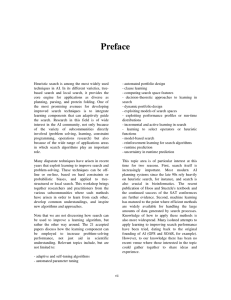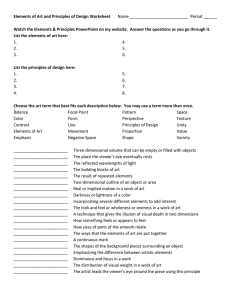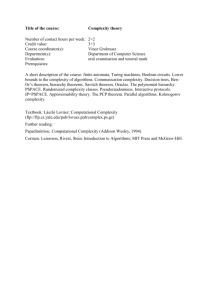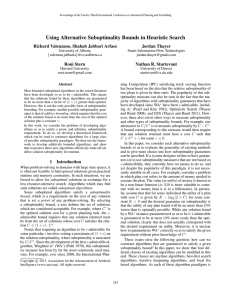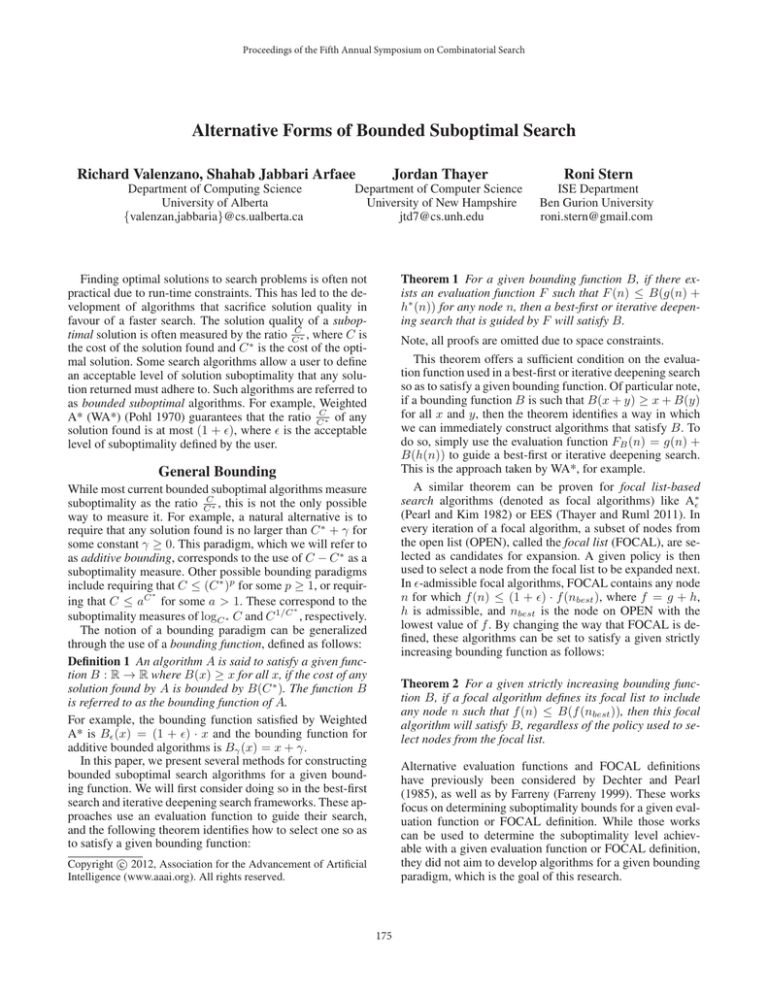
Proceedings of the Fifth Annual Symposium on Combinatorial Search
Alternative Forms of Bounded Suboptimal Search
Richard Valenzano, Shahab Jabbari Arfaee
Department of Computing Science
University of Alberta
{valenzan,jabbaria}@cs.ualberta.ca
Jordan Thayer
Roni Stern
Department of Computer Science
University of New Hampshire
jtd7@cs.unh.edu
ISE Department
Ben Gurion University
roni.stern@gmail.com
Theorem 1 For a given bounding function B, if there exists an evaluation function F such that F (n) ≤ B(g(n) +
h∗ (n)) for any node n, then a best-first or iterative deepening search that is guided by F will satisfy B.
Finding optimal solutions to search problems is often not
practical due to run-time constraints. This has led to the development of algorithms that sacrifice solution quality in
favour of a faster search. The solution quality of a suboptimal solution is often measured by the ratio CC∗ , where C is
the cost of the solution found and C ∗ is the cost of the optimal solution. Some search algorithms allow a user to define
an acceptable level of solution suboptimality that any solution returned must adhere to. Such algorithms are referred to
as bounded suboptimal algorithms. For example, Weighted
A* (WA*) (Pohl 1970) guarantees that the ratio CC∗ of any
solution found is at most (1 + ), where is the acceptable
level of suboptimality defined by the user.
Note, all proofs are omitted due to space constraints.
This theorem offers a sufficient condition on the evaluation function used in a best-first or iterative deepening search
so as to satisfy a given bounding function. Of particular note,
if a bounding function B is such that B(x + y) ≥ x + B(y)
for all x and y, then the theorem identifies a way in which
we can immediately construct algorithms that satisfy B. To
do so, simply use the evaluation function FB (n) = g(n) +
B(h(n)) to guide a best-first or iterative deepening search.
This is the approach taken by WA*, for example.
A similar theorem can be proven for focal list-based
search algorithms (denoted as focal algorithms) like A∗
(Pearl and Kim 1982) or EES (Thayer and Ruml 2011). In
every iteration of a focal algorithm, a subset of nodes from
the open list (OPEN), called the focal list (FOCAL), are selected as candidates for expansion. A given policy is then
used to select a node from the focal list to be expanded next.
In -admissible focal algorithms, FOCAL contains any node
n for which f (n) ≤ (1 + ) · f (nbest ), where f = g + h,
h is admissible, and nbest is the node on OPEN with the
lowest value of f . By changing the way that FOCAL is defined, these algorithms can be set to satisfy a given strictly
increasing bounding function as follows:
General Bounding
While most current bounded suboptimal algorithms measure
suboptimality as the ratio CC∗ , this is not the only possible
way to measure it. For example, a natural alternative is to
require that any solution found is no larger than C ∗ + γ for
some constant γ ≥ 0. This paradigm, which we will refer to
as additive bounding, corresponds to the use of C − C ∗ as a
suboptimality measure. Other possible bounding paradigms
include requiring that C ≤ (C ∗ )p for some p ≥ 1, or requir∗
ing that C ≤ aC for some a > 1. These correspond to the
∗
suboptimality measures of logC ∗ C and C 1/C , respectively.
The notion of a bounding paradigm can be generalized
through the use of a bounding function, defined as follows:
Definition 1 An algorithm A is said to satisfy a given function B : R → R where B(x) ≥ x for all x, if the cost of any
solution found by A is bounded by B(C ∗ ). The function B
is referred to as the bounding function of A.
For example, the bounding function satisfied by Weighted
A* is B (x) = (1 + ) · x and the bounding function for
additive bounded algorithms is Bγ (x) = x + γ.
In this paper, we present several methods for constructing
bounded suboptimal search algorithms for a given bounding function. We will first consider doing so in the best-first
search and iterative deepening search frameworks. These approaches use an evaluation function to guide their search,
and the following theorem identifies how to select one so as
to satisfy a given bounding function:
Theorem 2 For a given strictly increasing bounding function B, if a focal algorithm defines its focal list to include
any node n such that f (n) ≤ B(f (nbest )), then this focal
algorithm will satisfy B, regardless of the policy used to select nodes from the focal list.
Alternative evaluation functions and FOCAL definitions
have previously been considered by Dechter and Pearl
(1985), as well as by Farreny (Farreny 1999). These works
focus on determining suboptimality bounds for a given evaluation function or FOCAL definition. While those works
can be used to determine the suboptimality level achievable with a given evaluation function or FOCAL definition,
they did not aim to develop algorithms for a given bounding
paradigm, which is the goal of this research.
c 2012, Association for the Advancement of Artificial
Copyright Intelligence (www.aaai.org). All rights reserved.
175
Figure 1: Iterative Deepening on the 24-puzzle.
Figure 2: Focal Algorithms on the Inverse 15-puzzle.
Additive Bounding
is unlike a search guided by Fγ which will become increasingly greedy even as γ increases beyond 50.
When all actions are not of equal cost, BFS and iterative
techniques are generally less effective than the focal-based
approaches, which can more easily employ distance-to-go
heuristics (Thayer and Ruml 2011). Fortunately, Theorem 2
describes a simple way to adapt these -admissible focal algorithms to satisfy an additive bound.
These new additive algorithms, along with a best-first
search guided by Fγ , were tested on 100 instances of the
inverse 15-puzzle problems (Thayer and Ruml 2011). The
results of this experiment are shown in Figure 2. The admissible heuristic used is the cost-based Manhattan distance,
while the Manhattan distance ignoring action costs is used
for the distance-to-go heuristic.
As seen in the figure, the focal algorithms both effectively
sacrifice guaranteed solution quality for improved search
time. They are also significantly outperforming the best-first
search guided by Fγ , which is much less effective in this
domain than in unit-cost domains. This is consistent with
the behaviour seen when comparing WA* to the standard
-admissible versions of A∗ and EES.
Next, we use the theorems above to construct search algorithms with an additive bound. Following Theorem 1, one
might propose the use of the evaluation function F (n) =
g(n) + h∗ (n) + γ. However, it is easy to see that a best-first
search guided by this function will behave exactly like A*.
This means that there will be no speedup over A* when using this evaluation function, thus defying the reason for even
allowing for suboptimal solutions in the first place.
Instead, we propose the following function which can be
used to speed up search and still satisfy an additive bound:
Fγ (n) = g(n) + h(n) + γ · min(h(n)/h(ni ), 1)
where ni is the initial node and h is an admissible heuristic function. As Fγ (n) ≤ g(n) + h∗ (n) + γ clearly holds,
searching with this function will satisfy the additive bounding function Bγ (x) = x + γ by Theorem 1.
If we also have an inadmissible heuristic hi in addition to
the admissible h, then the following evaluation function will
also satisfy the additive bounding function by Theorem 1:
Fγ0 (n) = g(n) + min(hi (n), h(n) + γ)
This evaluation function is notable as it allows us to search
with guidance from an inadmissible heuristic while still satisfying an additive bound, which would not be possible if
the inadmissible heuristic were used alone.
Acknowledgments
This research was supported by NSERC and iCore.
References
Dechter, R., and Pearl, J. 1985. Generalized Best-First Search
Strategies and the Optimality of A*. J. ACM 32(3):505–536.
Farreny, H. 1999. Completeness and Admissibility for General
Heuristic Search Algorithms-A Theoretical Study: Basic Concepts
and Proofs. J. Heuristics 5(3):353–376.
Jabbari Arfaee, S.; Zilles, S.; and Holte, R. C. 2011. Learning
heuristic functions for large state spaces. Artificial Intelligence
175(16-17):2075–2098.
Korf, R. E., and Felner, A. 2002. Disjoint pattern database heuristics. Artificial Intelligence 134:9–22.
Pearl, J., and Kim, J. H. 1982. Studies in Semi-Admissible Heuristics. IEEE Trans. on Pattern Recognition and Machine Intelligence
4(4):392–399.
Pohl, I. 1970. Heuristic search viewed as path finding in a graph.
Artificial Intelligence 1(3-4):193–204.
Thayer, J. T., and Ruml, W. 2011. Bounded Suboptimal Search:
A Direct Approach Using Inadmissible Estimates. In IJCAI, 674–
679.
Experimental Evaluation
To demonstrate the effectiveness of these evaluation functions, we ran experiments with an iterative deepening search
on 50 24-puzzle problems. Results are shown in Figure 1.
The x-axis shows the additive bound used (γ) and the y-axis
shows the average number of nodes generated to solve the
instances (in log scale). The admissible heuristic used was
the state-of-the-art 6-6-6-6 PDB (Korf and Felner 2002),
while the inadmissible heuristic used was the bootstrapping
heuristic developed by Jabbari Arfaee et. al. (2011).
The figure shows that using Fγ can effectively sacrifice
guaranteed solution quality for improved search speed in a
similar manner as does WA*. Additionally, FBST (which
corresponds to Fγ0 when using the bootstrapping heuristic)
is also shown to outperform Fγ until γ ≥ 50. As hi (n) ≤
h(n)+50 for all n, any search guided by FBST with γ ≥ 50
will be equivalent to a search guided by F = g + hi . This
176

